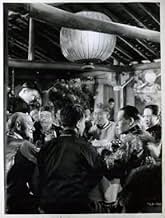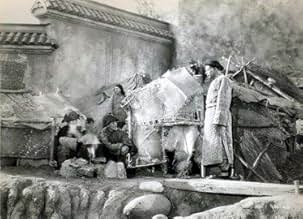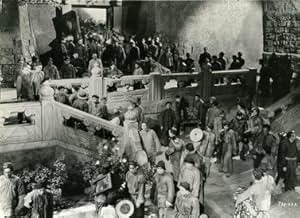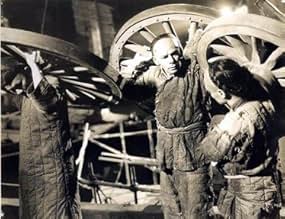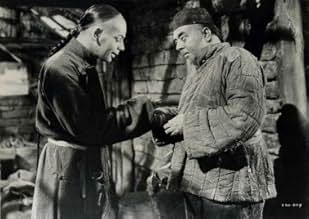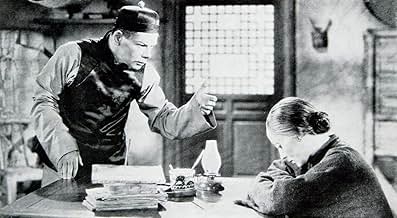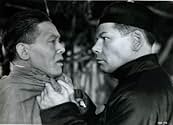Bien que les fermiers chinois mariés Wang et O-Lan connaissent d'abord le succès, leurs vies sont compliquées par des fortunes déclinantes et des périodes de vaches maigres, ainsi que par l'... Tout lireBien que les fermiers chinois mariés Wang et O-Lan connaissent d'abord le succès, leurs vies sont compliquées par des fortunes déclinantes et des périodes de vaches maigres, ainsi que par l'arrivée de la belle jeune Lotus.Bien que les fermiers chinois mariés Wang et O-Lan connaissent d'abord le succès, leurs vies sont compliquées par des fortunes déclinantes et des périodes de vaches maigres, ainsi que par l'arrivée de la belle jeune Lotus.
- Récompensé par 2 Oscars
- 7 victoires et 3 nominations au total
- Revolutionary Army Captain
- (non crédité)
- Man
- (non crédité)
- Teahouse Dancer
- (non crédité)
- Chinese Girl
- (non crédité)
Avis à la une
Luise Rainer was the beautiful star who had won the Best Actress Oscar the year before for her small role (and what a waste of an oscar) in "The Great Zigfield". It really didn't show what, if any, talent she had other than her exotic beauty. But in "Good Earth" she shows that she can really act! Her beauty was erased and she had no great costumes either. People say that she didn't show any real emotions in this film. Like hell. Her character Olan is a shy and timid woman, with inner strength. She is quiet during parts of the film with only her eyes and body to convey her emotions. Example: those scenes during the fall of the city and when looters were being shot. If you people are saying that she doesn't act well in this film, you are NOT looking!
Paul Muni shows that he can act as well. His character is not a likeable one to me. He never sees her for what she is, until the very end of the story. A sweet loving and dedicated wife and mother, with her own special beauty. The greatest one of all, the beauty from within, like a pearl.
If you get a chance to see this film, watch it. You will see one of the best films that the golden age of Hollywood created.
This is a truly great epic story of love, individual rights, class strata, and men/women issues. The centerpiece of the film is two brilliant performances by Luise Rainer and Paul Muni.
Muni plays Wang, a Chinese farmer, who is about to take a wife (Rainer). From the start, he treats her with respect, during a time when women were looked on as little more than hired help. Without giving too much of the movie away, they go through the highs and lows of all relationships, and even though the story may take place in late 19th/early 20th century,the story and much of their feelings, seems credible.
Other than the fact that the movie is about 5-10 minutes longer than it needs to be, and the performances of Charley Grapewin and Walter Connolly are typical 1930's cartoon characters, this is a really wonderful movie that, unfortunately, has become a victim of political correctness.
9 out of 10
From the very beginning of the picture, right after the lion's roar, we see the poignant tribute to Irving Thalberg, and we know that we are embarking on an important viewing experience. The scope of the story is very wide, and the filmmakers are up for the task. I was always struck by the abruptness of the final scene, but its power and beauty form an excellent example of the art achieved within the often cynical Hollywood film factory. And Lotus - the strangeness of her, and her dance, contrasted with the goodness of O-lan!
Aside from the oft-mentioned attributes of acting, photography and special effects, a major element in 'The Good Earth' is the score. Herbert Stothart may not be in the ranks of Hollywood's 'mighty handful' (Alfred Newman, Steiner, Tiomkin, Waxman, Herrmann), but his 'MGM-sound' scores regularly deliver the goods. True, Stothart had no hesitation in applying the syrup at first opportunity (one can imagine Louis B. Mayer positively ordering it), but in this picture, syrup gives way to sympathy. One of the pleasures of Hollywood's Golden Age films is that all the elements of a given film support each other, and great scores support not only the characters, but the entire film. Stothart's score is so sympathetic and so sincere, from the Main Title all the way through, and it enhances the story and the performances so naturally and at times transparently, that it must be considered a classic score. No great 'tunes' specifically, but plenty of effective mood, atmosphere and unabashed emotion. Many of today's audiences may find little to enjoy in such a combination, or they may be embarrassed by it, but I revel in it, as cinema such as this, which is delivered with such heart and good will is, especially in these times, nothing short of a gift.
The issue of non-Chinese playing Chinese characters has already been discussed on these pages, but I can only add: please, viewers, consider the film within the era that it was produced. The same kind of incongruity still happens today, perhaps not so much racially, but certainly culturally: Brad Pitt in 'Seven Years in Tibet', Keanu Reeves in 'Little Buddha', and other Americans getting plum roles in British-originated stories that become Hollywoodized, etc. When making 'Bhowani Junction', George Cukor considered using Indian actors, but vetoed any candidates in favor of familiar Hollywood faces. Never mind that in the 50s, as today, India had a huge film industry. It's just that those actors didn't fit into the Hollywood scheme of things. That speaks of box office more than political incorrectness. There is no doubt that fine actors like Philip Ahn should have gotten lead roles in pictures like 'The Good Earth', but at least we can enjoy them in supporting roles which carry a lot of weight in their own right. As time goes on, the context of past eras fades, while the films themselves, the really good ones, live on. There's plenty of opportunity for revisionist theses about issues like racial inequality in 1930s Hollywood, but for 138 minutes, it is compelling and moving to absorb onesself in the story and the atmosphere of 'The Good Earth'.
For those people who thought "The Good Earth" was dull and not entertaining, I have nothing to say. They are entitled to their opinion, but they missed one of life's most important lesson's: Humility and loyalty.
I was fortunate to see this film when it was FIRST released - in 1939. It's wonderful story (Pearl S. Buck) written for film (Talbot Jennings) has stayed with me all through my long life. I saw it in a theater then; I found it in the "garbage bin" in Wal-Mart this year (2011) and bought it immediately....I had it in a huge collection I gave to a library in Los Angeles when I moved to Florida. The copy I have now was made from the original cut - there are black screens between big scenes. I don't remember that after all these years, but accept it was the way the early release looked. It doesn't bother me - it gives me more time to think of what I have just viewed and anxious to see what's next. To me, the story is so engrossing the length of the film doesn't even occur to me - I would have liked the ending to be longer, because "Olan, you are the earth" told the entire reason for the story of true love and devotion, to the extreme.....
I'm not even bothered by the question so many people asked of why Paul Muni ("Wang Lung") and Luise Rainer ("Olan") were cast instead-of Asians - I had never seen Ms. Rainer in any film, and have no idea why her Hollywood career faded. She was considered to be a great beauty. Paul Muni I've seen in other films, but he wasn't one of my favorites. Yes, I have always wondered how "Gone with the Wind" - beat it out of an award: actually, I thought "The Good Earth" was filmed in color. Now, I'm not even concerned about that - the STORY, the ultimate entirety of the film's huge scenes and huge cast dismisses any negative comment I could think of, or read.
Walter Connolly ("Uncle") and Charlie Grapewin ("Old Father") were perfectly cast and played their roles with great skill. All of the cast were consummate in their roles; director Sidney Franklin held a strong grip of the totality of the film and got it all right. As time progressed into a more modern era, the characters became more modern: except, "Olan" stayed the wonderful woman she was.
However - Ms. Rainer stole the entire movie. A good actress does not always need words to say. I feel the story of a peasant-farmer and his ex-slave wife, all of the troubles they encountered (and defeated), the entire cast presented an accurate portrayal of the story in those days - China. It is hard for me to visualize any re-make could be better, and feel any CGIs would be completely unnecessary. It is also hard for me to realize China's last emperor was alive when I went to Hawai'i in 1969......living a peasant-life, just as did "Wang Lung" and "Olan".
Anyone who views "The Good Earth" and doesn't readily understand that life is bigger than any of us, haven't really lived. It gets a 20 from me - I recommend it to every living soul.
Le saviez-vous
- AnecdotesSpecial effects experts were unable to produce an authentic-looking locust plague. Just as they were about to abandon the scene, they received word that a real locust plague was taking place several states away. A camera crew was rushed to the scene to capture it on film.
- Gaffes(at around 2h 5 mins) Wang Lung is walking through the locust storm in his wheat field. He picks up a few men who have fallen down into the thick pile of locusts. In frustration, Wang shouts "I said save the wheat! Save it!" At this moment, a man dressed in 1937-era American clothing walks across the scene from left to right, at the top third of the screen. He is wearing a white hat and appears to be smoking a cigarette or cigar held in his left hand.
- Citations
Wang Lung: [must sell his land to feed his family but the buyers take advantage of him] Thieves! Thieves! And well you know I must sell.
O-Lan: No! Not the land. We'll not sell the land. We'll keep it. We'll go south and when we return, we'll still have the land.
Uncle: But I've arranged it. I brought these men here. You MUST sell!
O-Lan: Is it your land? Did you buy it bit by bit? The land is our life... and it's better to go south... or die walking... than to give it to you for nothing.
- Crédits fousIntroduction played with opening credits: The soul of great nation is expressed in the life of its humblest people. In this simple story of a Chinese farmer may be found something of a the soul of China - its humility, its courage, its deep heritage from the past and its vast promise for the future.
- ConnexionsEdited into Les Fils du dragon (1944)
Meilleurs choix
Détails
- Date de sortie
- Pays d’origine
- Site officiel
- Langue
- Aussi connu sous le nom de
- Visages d'Orient
- Lieux de tournage
- Cedar City, Utah, États-Unis(backgrounds for locust sequence)
- Société de production
- Voir plus de crédits d'entreprise sur IMDbPro
Box-office
- Budget
- 2 800 000 $US (estimé)
- Durée2 heures 18 minutes
- Rapport de forme
- 1.37 : 1
Contribuer à cette page




